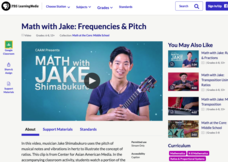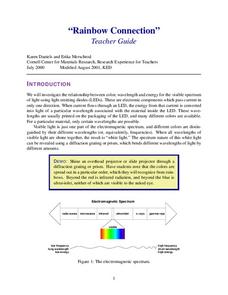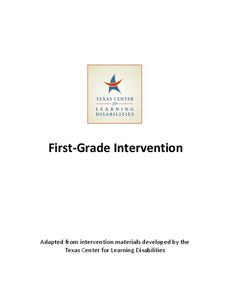Curated OER
Animal Alphabet
Review the alphabet and the sounds each letter makes before having learners identify animals whose names begin with each letter. Working in groups of four to six, they make an animal alphabet book with the letter, a picture of the animal...
Curated OER
Two Squares are Equal
This problem is sure to get your young mathematicians thinking. The idea sounds simple: one equation, solve it as many ways as you can. This is meant to get at a deeper understanding of solving quadratic equations, including some more...
Purdue University
Design of Music Instruments for a Rock Band
Can you create a rock band? Scholars learn about the creation and transmission of sound in a hands-on STEM activity. First, they explore the transmission of sound using a tuning fork. Then, they must solve the problem of missing...
Florida Center for Reading Research
Phonics: Encoding and Decoding, Vowel Stars
Learners are given a star; each star contains a c_c form in the center and vowels on each point. They use the vowels to fill in the blank between the consonants making a simple CVC word. They write each word they make on a piece of...
Acoustical Society of America
Good Vibrations
Visualize vibrations within the classroom. Pupils see the connection between sound and waves. The learners use a tuning fork in two different ways to demonstrate the waves associated with sound. Scholars see how the sound waves from a...
Acoustical Society of America
How Loud Is Too Loud?
How loud was that? Individuals build wheels displaying different sounds. Then, learners use the wheels to find the number of decibels the sound creates and how long they could withstand the sound before potential hearing damage.
PBS
Math with Jake: Frequencies and Pitch
Be an octave above the rest. A musician explains how to write music in different time signatures. An interesting resource continues to demonstrate ratios using the pitch of musical notes and hertz. Pupils use a pitch table and determine...
Let's Drum!
Let's Drum!
Here's a group of exercises designed to introduce a group or class to the rhythm, as well as the basic sounds of a drum, bass and tone. Individuals investigate different types of drums and form drum circles to practice traditional...
Texas Center for Learning Disabilities
Teacher Templates
Letter by letter, sound by sound, monitor the growth of your emergent readers with these assessment templates. Adaptable to the needs of individual students, these one-on-one assessments focus on children's ability to identify...
Acoustical Society of America
Musical Instruments: Part II
String together how instruments produce sound. Using pieces of string, learners find ways to create sound. They investigate changes to the string and the effect of adding a cup. Finally, pupils experiment by changing the way to create...
Reading Resource
Flip It Down - Advanced Code Reading Game
A fun twist on bingo helps your kids learn their vowel sounds. As you call out each word, kids flip the tabs on a gameboard to cover their words and be the first to cover them all.
PHET
Wave Interference
Why did the waves get into a fight? They were tired of each other's interference. Scholars observe the wave patterns from dripping water, sound waves, and light waves. They vary the spacing, build barriers, and increase the number...
Cornell University
LEDs Rainbow Connection
View LED lights through the eyes of a scientist. Young scholars learn to view light as a wave frequency and connect various frequencies to different colors on the light spectrum. A lab activity asks groups to measure the frequency of...
Texas Center for Learning Disabilities
First-Grade Intervention
Learning how to read is a big challenge for young learners, but this series of lessons provides them with the extra support they need to succeed. With each lesson following the a clearly outlined format, children are introduced...
ESL Kid Stuff
Zoo Animals
Let's go to the zoo! Take a pretend trip to the zoo with a lesson plan about animals that live at the zoo. Kids sing, match animals, practice animal sounds, and read about Sammy the Snake's birthday party.
K12 Reader
Change the Point of View: First Person and Third Person
How is a story different when told from various points of view? Learn about first and third person points of view with an activity based on Robert Louis Stevenson's Treasure Island. Readers examine a passage written in first person,...
Texas Center for Learning Disabilities
Second-Grade Explicit Intervention
Unfortunately, not all students learn to read at the same pace, but with the help of this resource, you can ensure that they all receive the support they need to reach this important goal. Comprised of short...
Bonneville
Introduction to Energy
Transform the classroom with energy. Pupils learn about different types of energy and practice identifying the types in the first lesson of six in a solar versus wind energy unit. The class sees examples of how one type of energy can be...
Curated OER
How Do Sounds Change?
In this sounds worksheet, students compare how different pitches and volumes of sounds are created. This worksheet is a graphic organizer.
Curated OER
/sh/ Sound Work
What letters create the /sh/ sound? Have your elementary learners study the sound, write different words that use the sound in their letter boxes, and read One Fish, Two Fish, Red Fish, Blue Fish! After this mini-lesson, can your...
Curated OER
Pronunciation: The Sounds /s/, /z/ or, /iz/? Consonant Clusters with "s"
Instruct your class on how to pronounce /s/ sounds with this resource. Learners fill in the final /s/ sound into blanks, listen to plural sounds, learn about the rules of the target sound, write sentences, and work with consonant...
Curated OER
Electricity Review
Are there different types of energy? Yes there are! Learn about the differences between heat, sound, light, and movement energy as they relate to electricity. This informative presentation could provide more detail explaining how light,...
Curated OER
"A Sound of Thunder" by Ray Bradbury: Questions
These questions are designed to accompany Ray Bradbury's "A Sound of Thunder," and could be used to guide and focus readers or as an assessment of reading skill and knowledge of the elements of a story. Page one focuses on questions of...
Curated OER
Puzzle Page
Who says your budding readers are too young for crossword puzzles? Scholars use visual clues instead of written ones to complete single-syllable words. They fill in the initial letter for each of six words, and a second letter for one of...

























